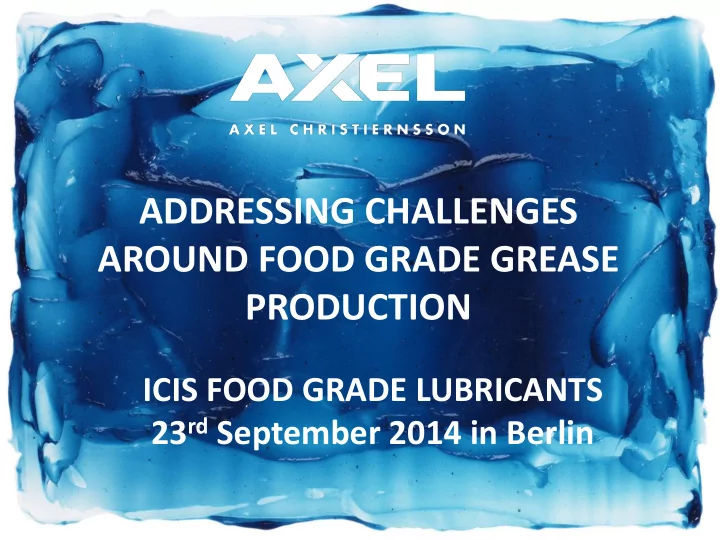

ADDRESSING CHALLENGES AROUND FOOD GRADE GREASE PRODUCTION ICIS FOOD GRADE LUBRICANTS 23 rd September 2014 in Berlin
What is Grease?
Grease is… “A solid to semi fluid product of a thickening agent in a liquid lubricant. Other ingredients imparting special properties may be included. ” ASTM D-288 , Annual Book of ASTM Standards, American Society for Testing and Materials. Grease is a thickened oil not a thick oil!
Base oil + Additives + Thickener 80-90% 2-7% 5-15%
Grease Composition BASE OIL THICKENER ADDITIVES + + MINERAL METAL SOAP ANTI-OXIDANT SYNTHETIC NON-SOAP CORROSION INHIBITORS EP / ANTI-WEAR VEGETABLE SOLID LUBRICANT DYES
Soap Thickener Fatty acid ( from plant or animal fats) + metal hydroxide (base, alkali) = Soap and Water
Lubricating oil are often Lubricating grease are more often classified by machinery type: introduced by thickener type and then by machinery type: • Hydraulic Oil • INORGANIC THICKENERS • Gear oil Clay, Silica Gels, PTFE, etc • Compressor oil • Chain oil • METAL SOAPS THICKENERS • Vacuum pump oil Anhydrous calcium, Calcium • Etc. Complex, Aluminum Complex, Calcium Sulphonate Complex, etc
LUBRICATING OIL MANUFACTURE PROCESS Additives Base Oils + 8 8 Mixer Mixed with or without heating Packaging During several hours
LUBRICATING GREASE METAL SOAPS THICKENER MANUFACTURE PROCESS
Grease Batch-production Example 205 Temperature [°C] 180 90 40 Time 0 Hrs 2 4 8 12 16 20 24
Quality Control Consistency Stability Corrosion protection EP/AW Performance Water tolerance Oxidation resistance Etc….
Properties and applications High load High temp. Low speed Water Greases Special High speed Environment Low temp.
Example: Food grade Aluminium Complex grease H1 Food zone • Thermal Stability Very good • Shear Stability Moderate • Water resistance Very good • Load carrying capacity Moderate Non-food H2 zone
Ordinary soap thickeners The soap and the additives are competing for the metal surface •Due to a higher degree of polarity the soap will mostly win •This limits additive response and performance in conventional soaps
Combination thickener & additives
Functional thickeners Example:Calcium Sulphonate Complex Grease Incorporation of additives in the soap structure •The soap will “carry” the additives to the metal surface increasing the additive response • However, some additives will inevitably be blocked in the middle
Lubricating grease based on EPOCH TM With a non-polar thickener system as the base, the additives can reach the metal surfaces and do their job.
Different Tribology System Closed Tribology System Opened Tribology System Less constraints More constraints Condensation D ust, Vapour, Dripping and leakage Cleanning solvent … Lubricating oil Lubricating grease
Factors Affecting Grease Selection Method of application Operating Temperatures Range Bearing size & load & Rotational speed Required length of service Environmental conditions (water, steam, chemicals)
Grease versus Oil • Lubricating ability • Sealing ability • Corrosion inhibiting ability • Carrying ability
Grease vs. Oil Lubricating Ability • Superior load carrying capacity • Acts as reservoir of lubricant
Grease vs. Oil Sealing • Prevents fluid and solid contaminants from entering • Eliminates problems with dripping and leakage • Allows more freedom in design parameters
Grease vs. Oil Corrosion Inhibiting Superior ability to adhere to metal surfaces Prevents reactive liquids from coming into contact with the metal surfaces
Grease vs. oil Carrying Ability • Consistency provides a firm matrix for additives • Prevents sedimentation
Advantages Grease VS Oil Greases act as a seal - no contaminants Greases do not need circulation systems Greases decrease dripping, splattering and leakage Greases suspend solid additives easily Greases are suitable for intermittent operations Greases reduce noise Bearing orientation irrelevant Life lubrication
Disadvantages Grease VS Oil Greases may not reach all places in need of lubrication due to less free- flowing ( Eg. chain lubrication ) Greases do not have any cleaning effect Greases do not work as cooling agent
REGISTRATION NSF or INS HALAL H1, 3H Registred KEY WORDS ISO 21469 KOSHER Certified
Main difference of certification process between lubricating oil and grease • In general, H1 registration processes for all lubricants are reviewed the same way, based on end use regardless of the type (oil vs grease) • Formulations, stick labels, MSDS
Main difference of certification process between lubricating oil and grease • Review the ingredients to appropriate regulations: Lubricating grease ≠ Lubricating oil Percentage of thickner should be take into account (21 CFR 178.3570) Not only each ingredients, but also if several ingredients would be reacted to form another ingredients during the saponification, the use level limitations of the finished ingredient should also be take into account
Product Registration VS Product Certified NSF H1 Registered ISO 21469 Certified Formulations & Labels & YES MSDS Manufacture process Raw material and YES finished product stockage NO Contamination risk evaluation and prevention actions – Audit Annual Sample testing
ISO 21469 COMMITMENT to COMPLIANCE ISO 21469 is a relatively new hygiene standard and the certification involves a four step accreditation process; 1. Review of formulations and labels 2. Risk assessment 3. Physical audit of the production facility Certified dedicated 4. Annual testing production unit at AXEL FRANCE (Since 2009)
Thanks for your attention!!! Questions??? Zhaoying YU Food Grade Group Product Manager AXEL CHRISTIERNSSON Zhaoying.yu@axelch.com
Recommend
More recommend